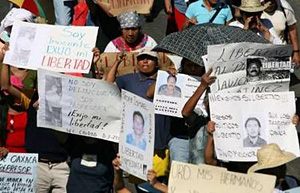 |
 |
 |
 Editorials | Issues | December 2006 Editorials | Issues | December 2006  
Mexico 2006: Oaxaca, an Irreversible Crisis
 Cira Rodriguez Cesar - Prensa Latina Cira Rodriguez Cesar - Prensa Latina


| | Supporters of the Popular Assembly of Oaxaca (APPO) take part in a march against the Governor of Oaxaca Ulises Ruiz and Federal police (PFP) in Oaxaca City December 10, 2006. The demonstrators held photographs of people arrested during and after a riot in late November. (Reuters/Daniel Aguilar) |
The Oaxaca social conflict that broke on May 22 in Mexico, with 70,000 local teachers demonstrating for higher salaries, became the most significant political, social crisis in the country in the last few years.

On that day, teachers of Section 22nd of the National Education Workers Union could not even imagine they would start an irreversible process that includes many commitments.

Slowness and disdain of federal authorities, intransigence of a local governor who is clung on to power, the framework of interests of Revolucionario Institucional (PRI) and Accion Nacional (PAN) parties, as well as the presence of police forces have all turned Oaxaca into a vicious circle.

But, contrary to what politicians and observers may think, this southern Mexican coastal state is today a powder keg, where a solution to the conflict gets complicated, as the domination system prevailing there was broken, and reconstruction of society cannot be guaranteed by repression.

Far from serving as a dissuasion factor, state constraint has encouraged resistance against Governor Ulises Ruiz, who for more than six months has been urged to resign his post due to the high level of ungovernability prevailing in the area.

Known as land of the sun, indigenous sanctuary of Mexico, birthplace of national heroes and other names, Oaxaca is among worst hit Mexican places when it comes to poverty, marginalization and backwardness.

At least 40 percent of its economically active population do not get any payment for their work, and 60 percent of those lucky to be paid earn less than a minimal wage a day. In contrast, just a tyre of one of the governor's cars costs 2,400 dollars.

In the light of these realities, on June 14 Ruiz ordered a brutal removal of teachers and social activists from their sit-ins, all of which left 92 people wounded, including several with serious injuries, according to official figures. A strong popular movement followed.

Then, led by Oaxaca's Popular Assembly of the Peoples (Asamblea Popular de los Pueblos de Oaxaca, APPO), grouping unions, as well as indigenous, students, worker organizations and several settlers, Oaxaca residents gave free rein to a broad mass movement of a unitary, opposition nature.

Successive clashes with local and state police ensued, including the occupation of main government buildings, the lifting of barricades, street blockings and occupation of Universidad Radio, all of which were responded by arbitrary detention, torture and violation of individual guarantees.

Based on a skillful policy of alliances, APPO managed to build a network of resistance and peaceful civil disobedience capable of facing the state executive and paramilitary groups, only stopped by the entry of Federal Preventive Police (PFP) into Oaxaca on October 29.

However, a lack of sensitivity in the Congress of the Republic to declare the disappearance of powers in the area triggered not only a radicalization of APPO, but also the most violent clash with PFP, with 17 people killed and more than 284 detained.

Over 10 rounds of talks between APPO and representatives of the Ministry of Interior and efforts made by senators and deputies bared no fruit in finding a solution to the conflict.

Stuck in political interests of PRI and PAN, the Oaxaca crisis is in a blind alley, on the brink of an increased social violence, especially after the detention of main APPO leaders.

In opinion of the country's opposition progressive forces, the Oaxaca conflict is a complex political issue that requires the resignation of the state governor to be solved, as many recognize.

It is a reflection of ungovernability and incapacity to build bridges of understanding, as well as incompetence to channel social demands with firm, radical solutions. | 
 | |
 |



